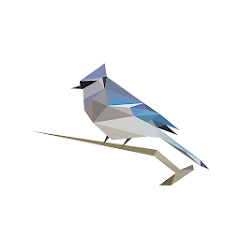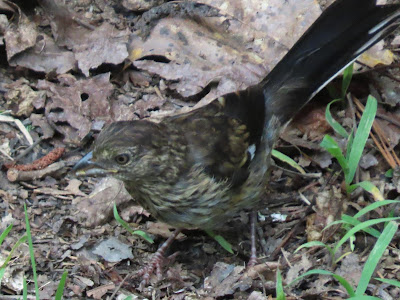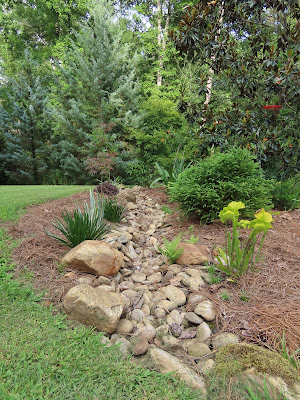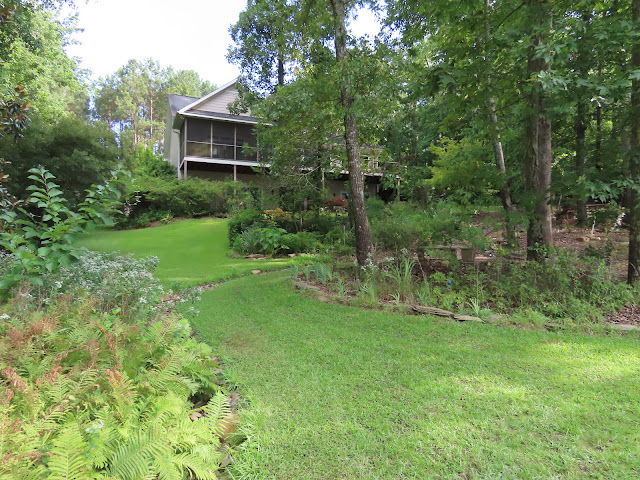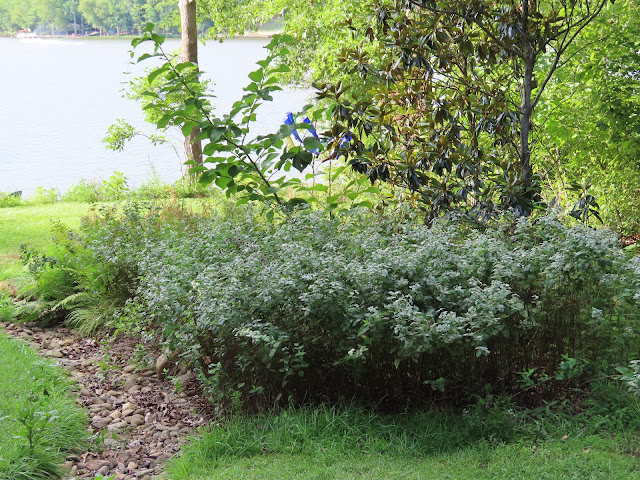We have an abundance of wildlife in our area. Sure there are deer and turkeys and fox and even coyote. The wildlife I am writing about is more in the reptile family tree. We have many snakes in our neighborhood and only one is venomous, the Copperhead. There others in nearby counties, but in Greenwood it is the Copperhead you need to be aware of.
Let's start with some less frightening reptiles. Who doesn't love a baby turtle? How about a handful of three newly hatched turtles? I came across these little ones while planting a hydrangea along the side of the house. After a quick picture, I put them back where I found them.
Fast forward ten years, came across another newly hatched turtle in the same area of the garden.
Now that we have touched on some of the legged reptiles (and there are so many others- multiple Skinks and Glass Lizards), it is time to venture to the snakes in the Upstate of South Carolina. Now you can ask some self-proclaimed experts and they will tell you about lots of venomous snakes. Not true. I have a few sources to back up my information. One of the best is the Savannah River Ecology Lab from the University of Georgia. I have two friends, one retired from and one currently employed by Department of Natural Resources in South Carolina. I have one almost on speed dial. He backs up all his identifications with a link to the said snake's ID document.
So let's look at the snakes I see regularly in my yard/garden.
I will ease you in slowly- Here's a pretty one-
Above and below- Rough Green Snake. It is a lovely emerald green and quite small. Their diet is insects, spiders and other small invertebrates.
On to the various black snakes we have.
There is the Black Racer, who is really fast. These guys will really move through the garden to get away from you. They are mostly black with a little bit of white under their chin. Their diet is mostly insects, other snakes, lizards, birds and amphibians.
 |
| Black Racer |
Next is the Blackrat Snake. Their diets include lizards, frogs and rodents (yea!). They are also fond of duck eggs. They are quite common in our area and while mostly black, they have a good bit of white on them. They will try to look tough to scare you away.
 |
| Black Ratsnake |
If frightened they will 'freeze' and assume a kinked position. In the grass that helps them disappear, though not so much on the pavement.
 |
| Black Ratsnake |
The juvenile Rat Snake is more varied in coloration.
 |
| Juvenile Black Ratsnake |
I find I have a resident Rat Snake near the dryer vent. I tried to pull it out one time, but he held fast. It is in the space between the ductwork and the wall. Always fun to be in the wild!
The third black colored snake that is common in our area is the Eastern Kingsnake. They are black with white markings that look like cyclone fencing to me. It is one you want to have around if there are Copperheads- Kingsnakes eat Copperheads. Their diet includes snakes, lizards, rodents, turtle eggs, and birds. They are resistant to the venom of the Copperhead.
 |
| Eastern Kingsnake |
 |
| Worm Snake |
A couple that I confused with each other- Redbellied Snake, who feeds on slugs,
 |
| Redbellied Snake |
 |
| Redbellied Snake |
and DeKay's Brown snake. They are closely related. Brown snake also eats slugs as well as earthworms and other small invertebrates.
 |
| DeKay's Brown Snake |
Another small snake is a Ringneck Snake- pictured below is a hatchling next to a piece of pine straw. They can grow to 10 - 15 inches in length. Diet includes amphibians, small invertebrates, and lizards.
 |
| Ringneck Snake |
Not to be confused with the Redbellied snake, there is also a Red-bellied Watersnake. While they are a water snake, they can be found in the yard. They eat primarily amphibians but also eat fish.
Note the red/orange underside of the snake. They are really attractive.
 |
| Red-bellied Watersnake |
Another colorful snake is the Corn Snake. They eat larger prey- birds, small mammals, lizards and reptiles.
 |
| Corn Snake |
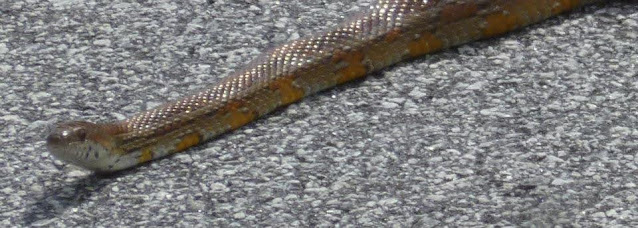 |
| Corn Snake |
Next come two that are closely related, both water snakes. First Northern Watersnake. This snake is often confused with a Cottonmouth (venomous) snake. Cottonmouth or water moccasin have different markings, bands instead of blotches. The Northern Watersnake's diet is primarily fish and amphibians.
 |
| Northern Watersnake |
 |
| Northern Watersnake |
The other watersnake is the Brown Watersnake. It is not common in our area but seem to be showing up more often in recent years. This photo was shared by a neighbor, wanting to know friend or foe. The Brown Watersnake's diet is primarily young catfish.
 |
| Brown Watersnake photo credit Barb Warner |
Finally we come to our venomous snake. The Copperhead. Their most distinctive marking is on their side- it looks like a Hershey' kiss. This is a snake to avoid. Another neighbor sent me this photo, asking what it was. She was walking, looking elsewhere and tripped over it!!! Young Copperhead snakes have a yellow tip to their tail, very distinctive. Their diets are pretty wide. They eat small mammals, birds, lizards, and other reptiles.
 |
| Copperhead photo credit Laurie English |
Thanks for following along with me on our photo journey of snakes in the Upstate of South Carolina. There are other snakes I did not profile as I have not seen them. I have comments allowed, if you comment, please sign your name so I know who has visited.
Many thanks to my phone-a-friend buddy Win Ott.









